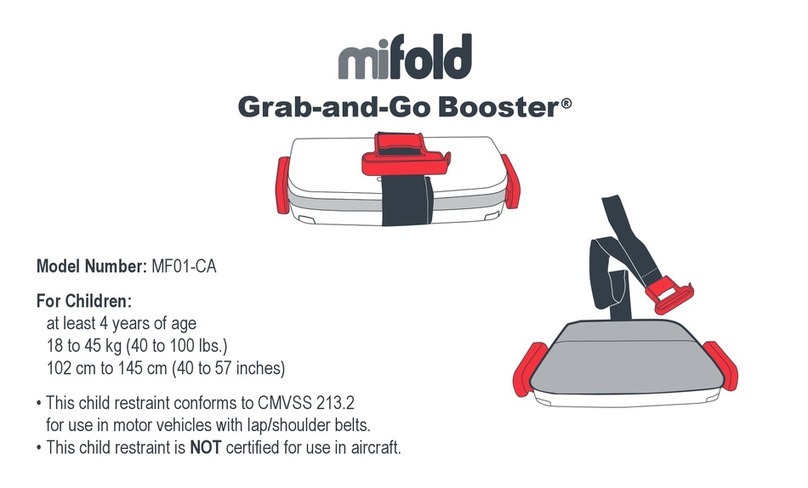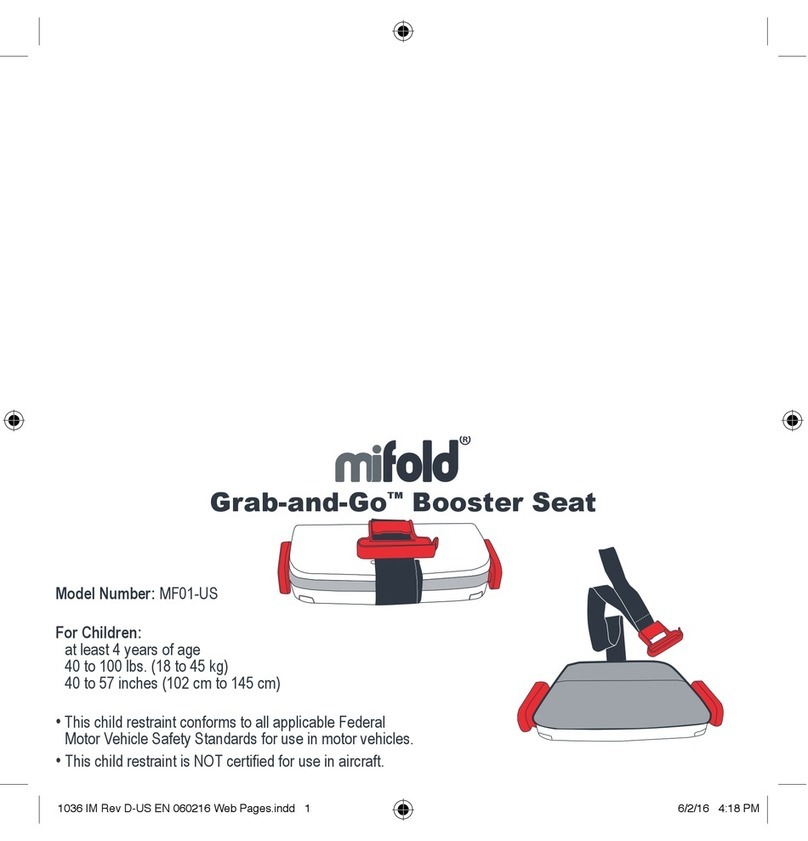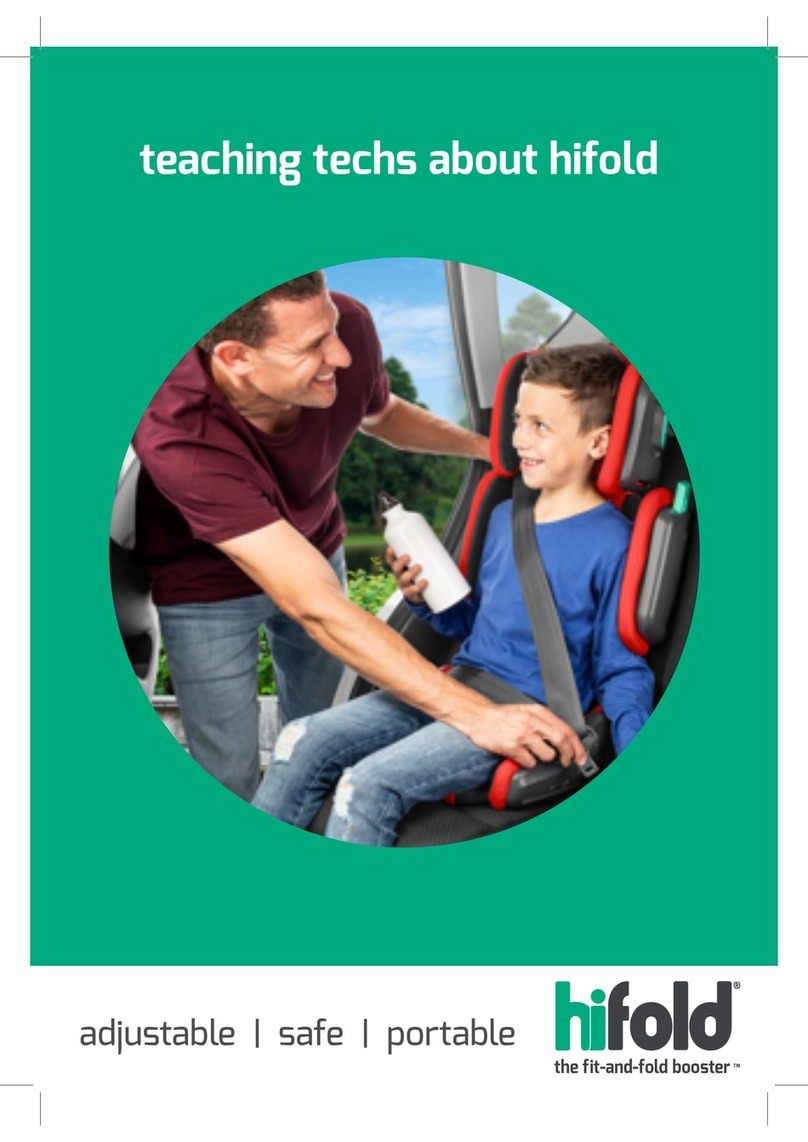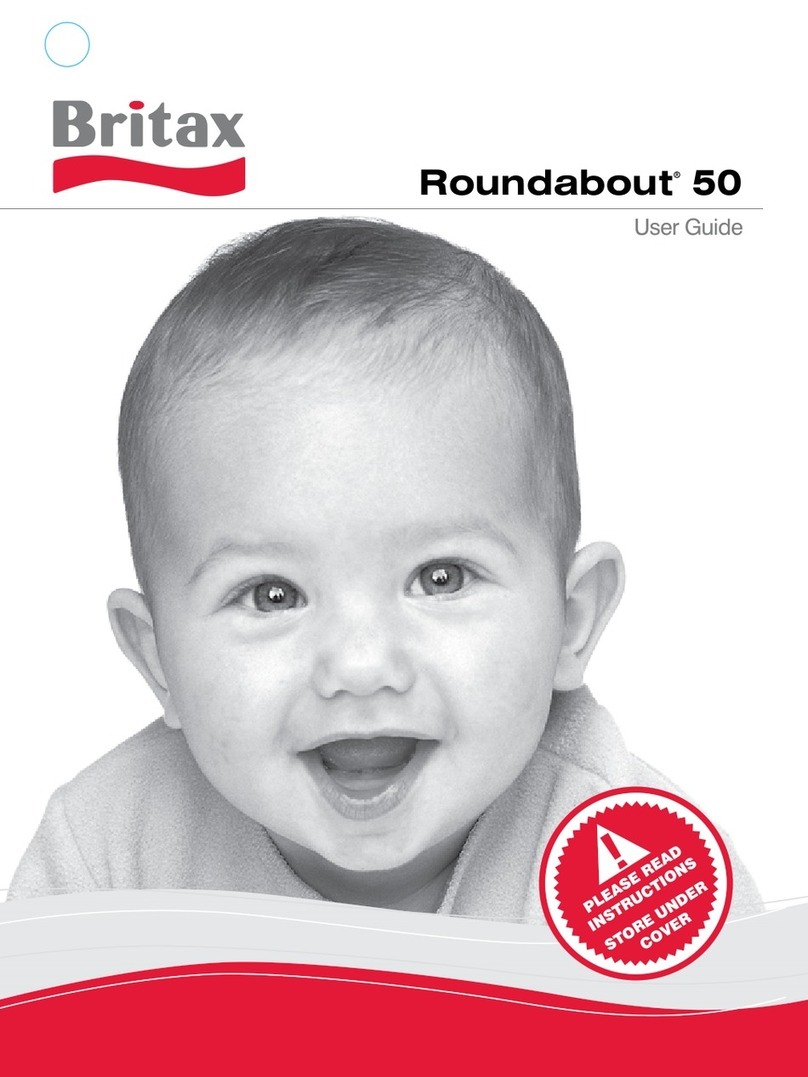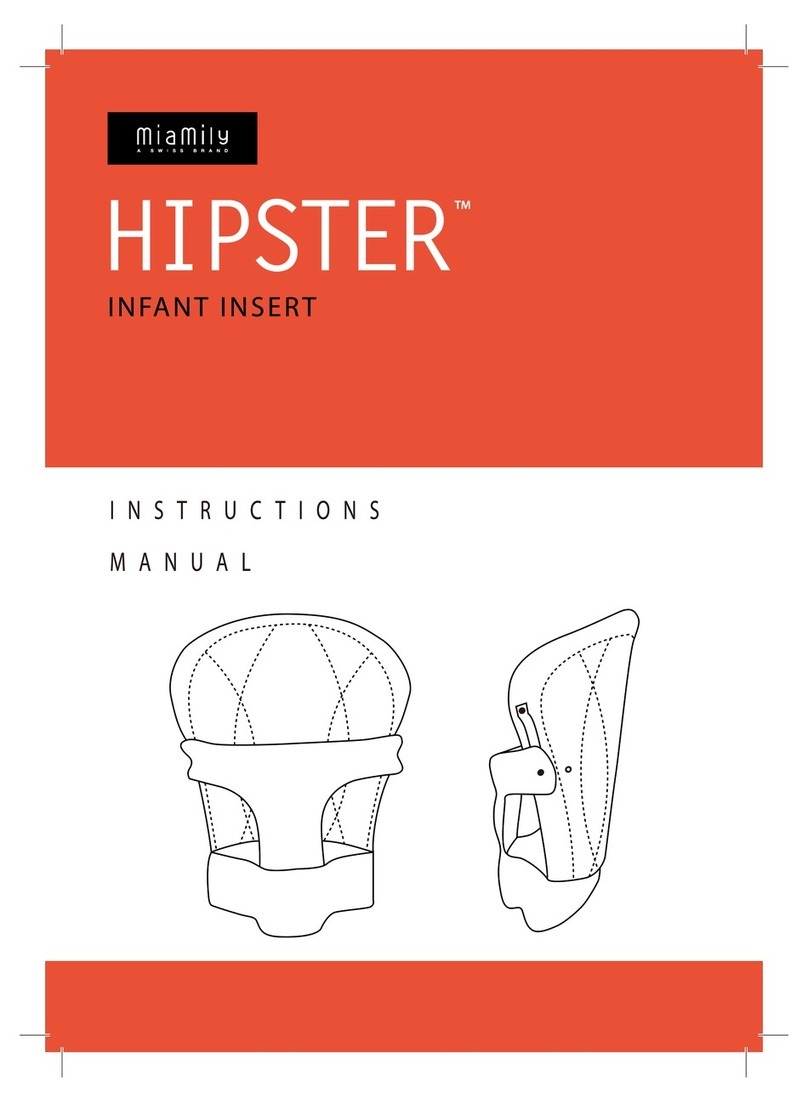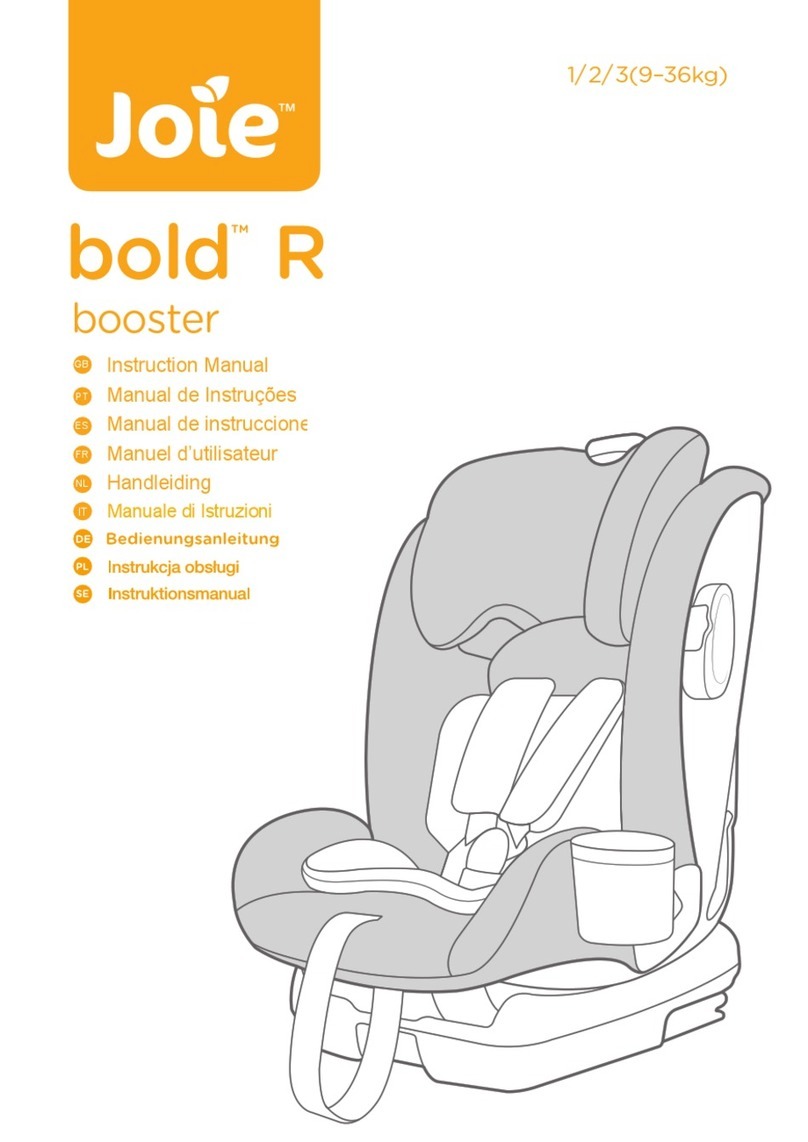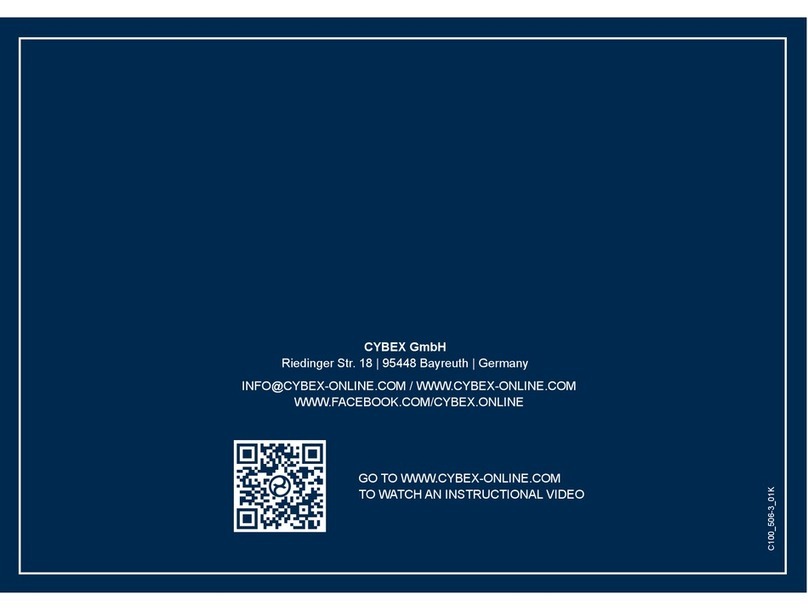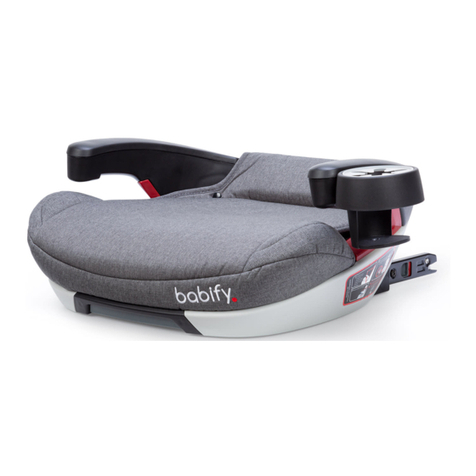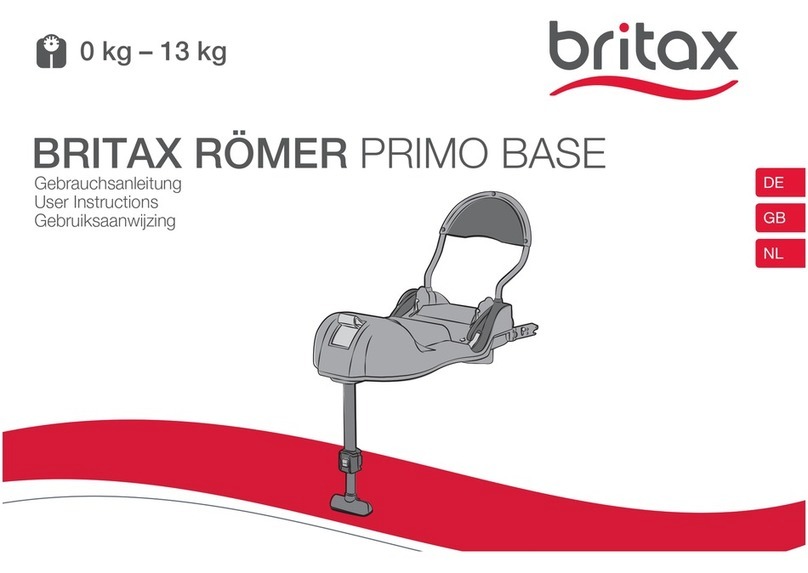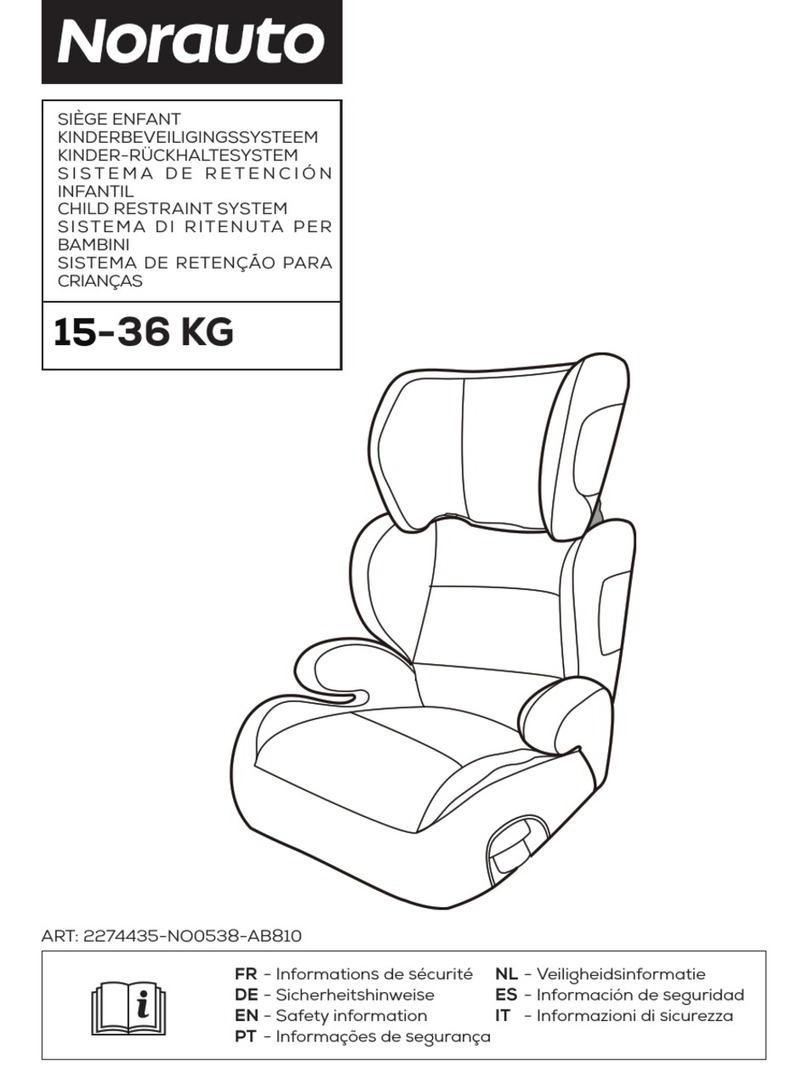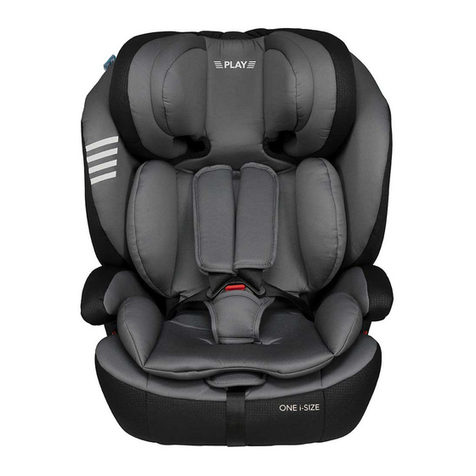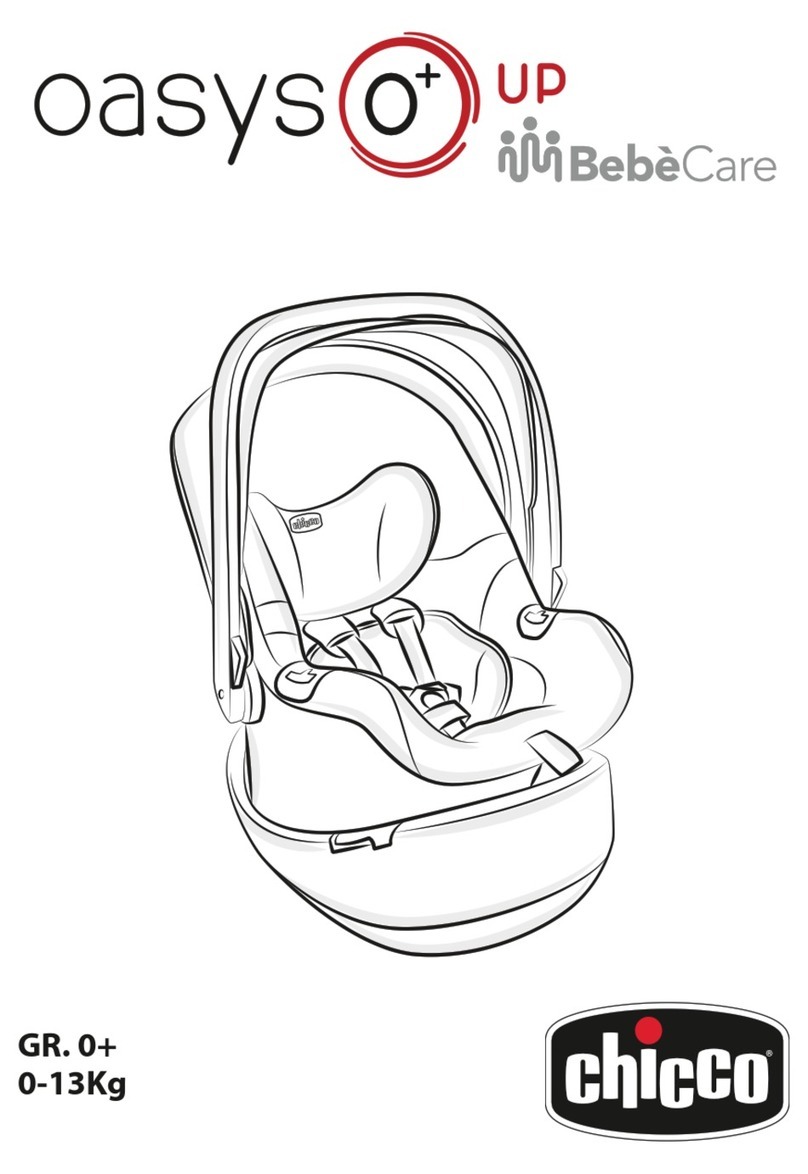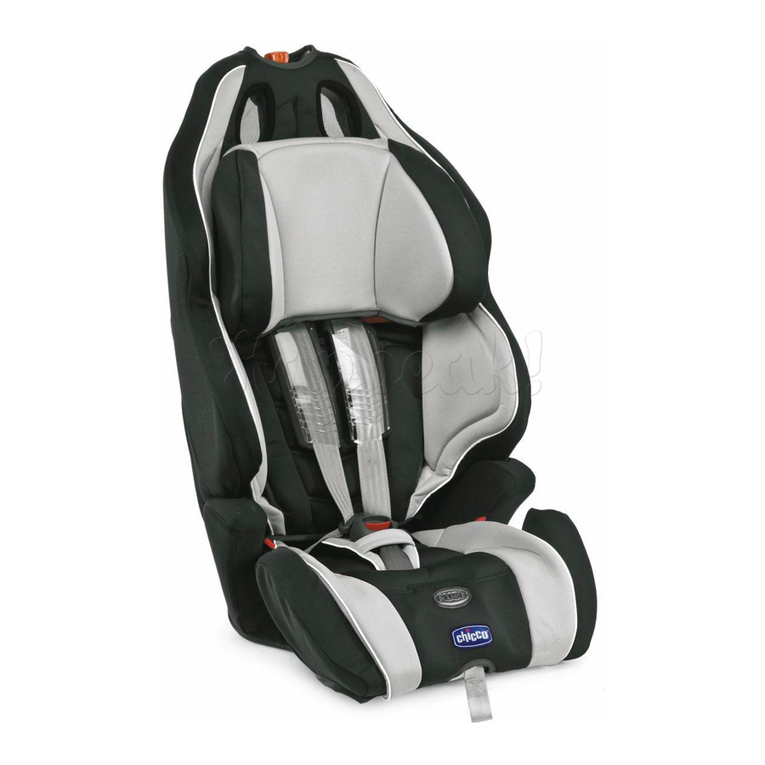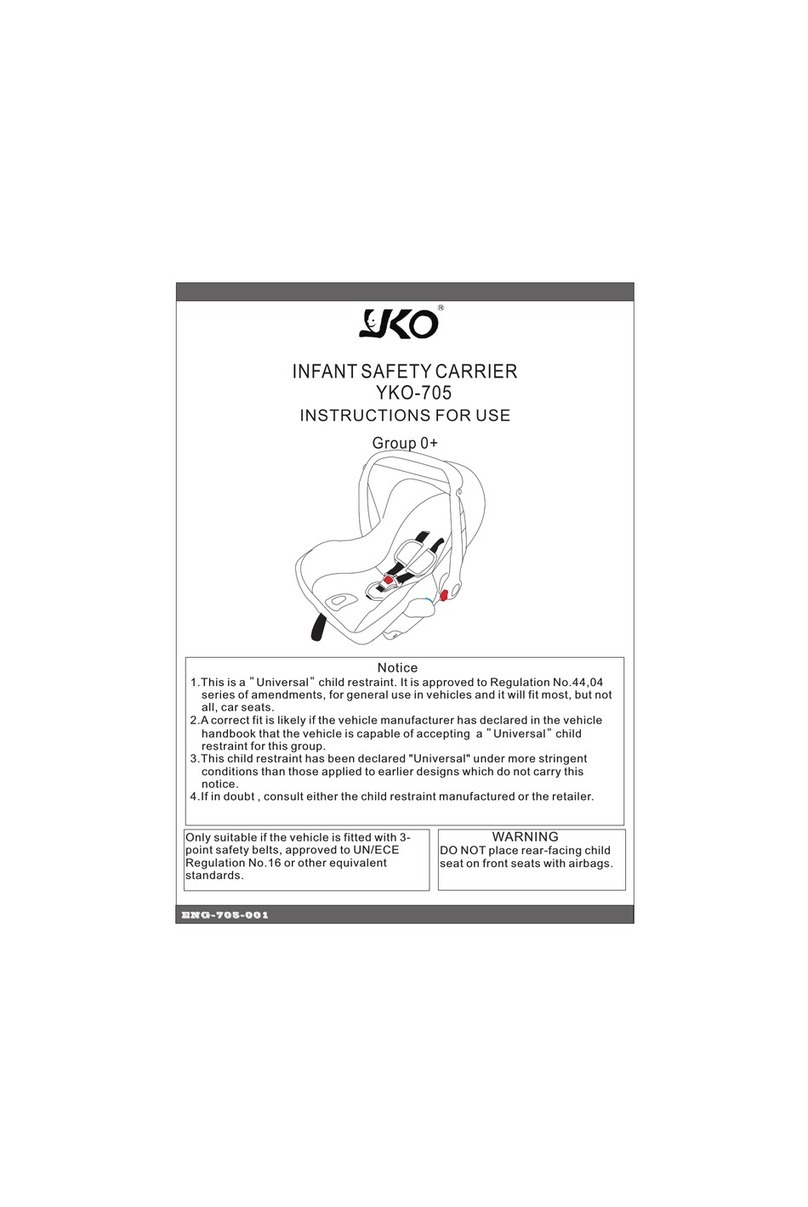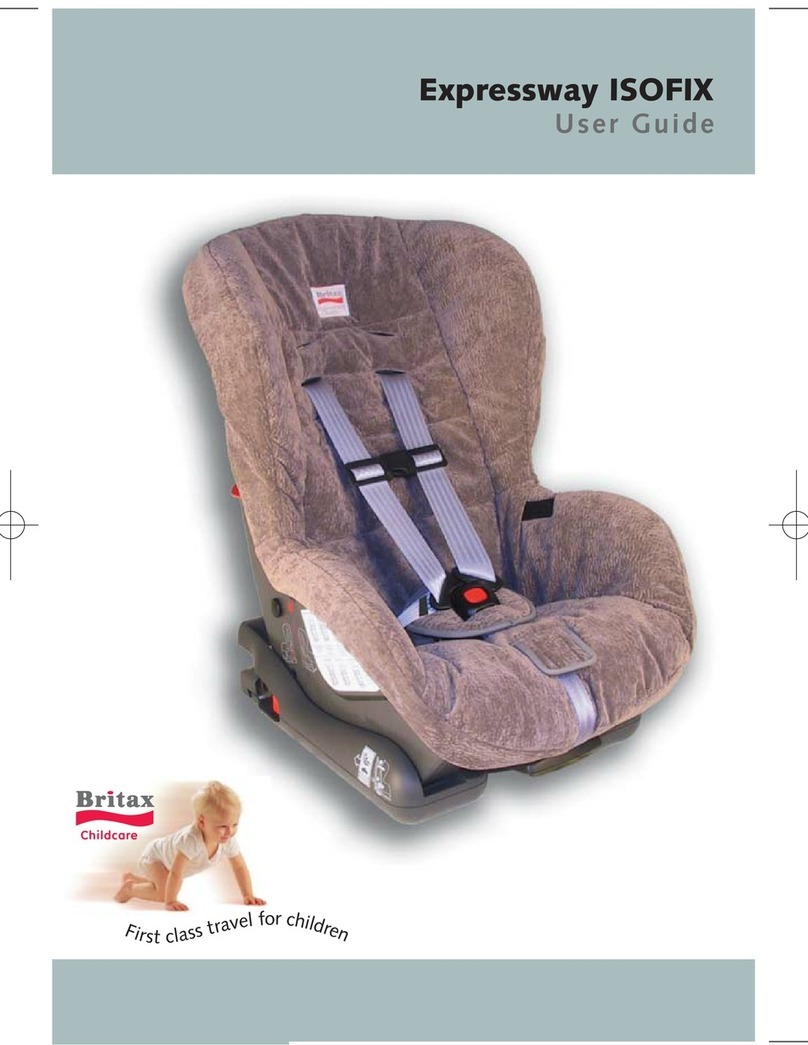Mifold Grab-and-Go Booster MF12-CA User manual

Grab-and-Go Booster
®
Model Number: MF12-CA
Globally Regulated Version
For Children:
at least 4 years of age
18 to 45 kg (40 to 100 lbs.)
91 cm to 150 cm (36 to 59 inches)
•This child restraint conforms to all applicable Canadian
Motor Vehicle Safety Standards 213.2 for use in motor
vehicles with lap/shoulder belts.
•This child restraint is NOT certied for use in aircraft.
Grab-and-Go Booster®

1
Table of Contents Weight and Height
Use Recommendations
• Child MUST be at least
4 years old.
• Child’s weight MUST be
between 18 and 45 kg
(40 and 100 lbs.).
• Child’s height MUST be
between 91 and 150 cm
(36 and 59 inches).
• Use only with a child that has outgrown their car
seat with a 5-point harness and can sit in the
booster seat properly for the entire duration of each
trip. If your child will not remain seated properly,
your child should use a child restraint with a
5-point harness.
Weight and Height Use Recommendations ...........
mifold - Booster Seat Parts .....................................
Warnings ................................................................
Proper Use Checklist ...............................................
Selecting a Vehicle Seating Location .....................
Vehicle Seat Belt Systems ......................................
Storing Your Booster Seat ......................................
Note About Switchable Retractors ..........................
Booster seat Installation ..........................................
Securing Child on Booster Seat ..............................
Removing Child from Booster Seat .......................
Removing and Storage of Booster Seat .................
Re-Use After a Crash ..............................................
Additional Information ..............................................
1-2
3
4-5
6
7-9
9-10
11
11
12-13
14-17
18
18-19
19-20
21-23

2
- A booster seat is designed to position the adult
vehicle belt correctly on the child.
- Vehicle lap belt MUST be positioned on the
pelvis such that it is low on hips, contacting highs
and not up on the abdomen.
- Full width of vehicle shoulder belt MUST be
on child’s shoulder (not in contact with the
Neck and not off the shoulder).
• Child restraint laws vary from province to province.
Check your local laws as they may have specic
use requirements.
• DO NOT use when:
- Child does not remain seated properly or does
not keep the vehicle belt properly positioned.
- Child’s weight exceeds 45 kg (100 lbs.).
- Child’s height exceeds 150 cm (59 in.).
- The vehicle belt ts on your child correctly
without a booster seat.
• Child MUST be at least 4 years old.
• Child’s weight MUST be between 18 and 45 kg
(40 and 100 lbs.).
• Child’s height MUST be between 91 and 150 cm
(36 and 59 in.).
• Use only with a child that has outgrown their car
seat with a 5-point harness and can sit in the
booster seat properly for the entire duration of
each trip. If your child will not remain seated
properly, your child should use a child restraint
with a 5-point harness.
• “Outgrown” means the child’s weight or height
exceeds the use limits for the car seat.
• “Sitting properly” means the child must remain
seated without slouching under lap belt, moving
shoulder belt under arm or behind back, or leaning
forward or sideways moving out of position so
the vehicle belt remains properly positioned.
Weight and Height
Use Recommendations

3
mifold - Booster Seat Parts
Shoulder Belt
Guide Strap
Seat Pad
Lap Belt Guide
Lap Belt Slot
Lap Belt Guide
Release Button
Lap Belt Guide
Lap Belt Slot
Shoulder Belt Guide
Storage Clip
Shoulder Belt Guide
Adjustment Clip
Shoulder Belt Slot
Booster Seat Lap Belt Guide
Release Button

4
Failure to follow these instructions and car seat
labels can result in child striking the vehicle’s
interior during a sudden stop or crash.
• Proper use is required:
- Read and follow all instructions and information
in this manual, product labels, and in the vehicle
owner’s manual for Booster Seat and vehicle
seat belt use.
- Improper use of the Booster Seat or vehicle
seat belt can result in serious injury or death
from a sudden stop or crash.
• Use ONLY with children who weigh between
18 and 45 kg (40 and 100 lbs.) and whose height
is between 91 and 150 cm (36 and 59 inches) and
are at least 4 years old.
• Use only the vehicle’s lap and shoulder belt system
when restraining a child in this Booster Seat. Lap
belt portion MUST be inserted through both belt
guides.
•Snugly adjust vehicle lap and shoulder belt around
child according to vehicle owner’s manual.
•Always properly position vehicle belts on child and
snugly adjust vehicle belts around child.
- Vehicle lap belt MUST be positioned low on hips,
contacting thighs and not up on the abdomen.
- Vehicle shoulder belt MUST be centered on
child’s shoulder (not touching neck and not off
shoulder).
- NEVER use shoulder belt loose, positioned
under child’s arm, or behind child’s back.
WARNING -
DEATH or SERIOUS INJURY can occur

5
•NEVER use Booster Seat with only a vehicle lap
belt across front of child. Use of lap belt only can
result in serious injury or death.
• NEVER use Booster Seat in a vehicle front seat
location unless recommended in vehicle owner’s
manual.
• Discontinue use of Booster Seat when top of child’s
ears are above top of vehicle seat back or headrest.
Severe head and neck injuries can result without
proper head support.
• NEVER use this Booster Seat with vehicle’s UAS
car seat attachment system.
• Secure Booster Seat even when not occupied.
Unsecured items may injure other occupants in
a crash.
• DO NOT use Booster Seat if it has been in a crash
or is damaged, missing parts or the instruction
manual is missing.
• Register child restraint with the manufacturer.
See Registration section.
• NEVER leave child unattended.
•
This Booster Seat is certied for use in motor vehicles.
DO NOT use this Booster Seat in the home, on boats,
on aircraft or other non-certied applications.
• Only use Booster Seat on forward-facing vehicle
seats with child facing front of vehicle.
•
Do not use this child restraint 7 years after the original
date of purchase (proof of purchase required) or
manufacturing date printed on the Shoulder Belt
Guide Adjustment Clip otherwise. Please keep a copy
of your invoice with your instruction manual in the
manual storage location.
WARNING -
DEATH or SERIOUS INJURY can occur

6
√ Booster Seat and child’s back MUST make contact
with vehicle seat back.
√Vehicle Lap and Shoulder
Belt MUST be properly
positioned on child.
- Lap Belt low on hips,
contacting thighs and
not up on the abdomen.
- Shoulder Belt centered
on child’s shoulder.
- Lap and Shoulder Belt
snugly adjusted around child.
√If the vehicle owner’s manual allows a car seat
to be placed in the seating position with a frontal
airbag, adjust seat back, away from airbag, as far
as possible according to the vehicle owner’s
manual.
√Child MUST be sitting up, with back against vehicle
seat back not slouching down under Vehicle Lap
Belt.
√Top of child’s ears are below
top of vehicle seat back or
vehicle headrest.
No car seat can guarantee protection from injury in
every situation, but proper use helps reduce the risk
of serious injury or death.
Proper Use Checklist

7
•Select a vehicle seating location that faces the front
of the vehicle and has a Vehicle Lap and Shoulder
Belt system.
• DO NOT use Booster Seat in a seating position
with a frontal air bag unless recommended by
the vehicle manufacturer.
• DO NOT use Booster
Seat with a Vehicle
Lap Belt ONLY.
• Refer to vehicle owner’s manual for information
on securing children and vehicle seat belt use.
• NOT all vehicle seat belts can be used with the
Booster Seat. Read vehicle owner’s manual on
Booster Seat use and the “Vehicle Seat Belt
Systems” section in this manual.
Selecting a Vehicle Seating Location
DEATH or SERIOUS INJURY can occur
WARNING
Select a Seating Location To Use:

8
1. Universal Anchorage System (UAS):
• Do not use the
vehicle Universal
Anchorage System
(UAS) with this
Booster Car Seat.
2. Side Facing and Rear Facing Seats:
• DO NOT use on side or rear-facing vehicle
seats.
Side Facing
Vehicle Seats
Rear Facing
Vehicle Seat
Universal Anchorage
System (UAS)
Selecting a Vehicle Seating Location
Vehicle Seating Locations NOT To Use:

• This Booster Seat MUST be used with a Vehicle
Lap and Shoulder Belt system. DO NOT use the
Vehicle Belt systems in this section.
1. Lap Belts ONLY Systems:
Vehicle Seating Locations With ONLY A
Lap Belt:
• Do NOT use seating
locations with Lap
Belt ONLY.
9
Lap Belt Only
According to accident statistics, children age 12
and under are safer when properly restrained in the
rear seating positions rather than the front seating
positions. For vehicles with air bags, refer to vehicle
owner’s manual for child restraint installation
information.
DEATH or SERIOUS INJURY can occur
WARNING
Vehicle Seat Belt
Systems
Select A Vehicle
Seating Location
•The back seat is the safest place for children 12
and under.

10
2. Passive Restraint Systems:
A. Motorized Shoulder Belts:
• Do not use
seating locations
with motorized
shoulder belts.
2. Passive Restraint Systems:
A. Motorized Shoulder Belts:
• Do not use
seating locations
with motorized
shoulder belts.
Motorized
Shoulder Belt
B. Door Mounted Lap And Shoulder Belt:
• Do not use front
seating locations
where seat belts
are mounted to
the door.
C. Inatable Seat Belt Systems:
• mifold has revised its recommendations based upon an analysis of vehicle seat belt system test results.
The Ford Motor Company Inatable seat belt system tted to Ford and Lincoln model vehicles is approved
for use with the mifold grab-and-go booster seat under model number MF12-CA. (The model number is
printed on the Shoulder Belt Guide Strap).
Belts Mounted
To Door
Vehicle Seat Belt Systems

12
11
A note about switchable retractors:
Many vehicles have a lap and shoulder belt system in which the
retractor can be switched from the emergency locking mode (ELR)
to an automatic locking mode (ALR). The ALR mode is not
designed for use with booster car seats and mifold is not
recommended for use with a lap and shoulder belt in the ALR mode.
Note: Should the lap and shoulder belt inadvertently be switched
into the automatic locking retractor mode (ALR) and the vehicle
seat belt is locked, follow the steps below to remove the lap belt.
1. Pull out and hold the shoulder belt to prevent further retraction.
Be aware not to allow shoulder belt webbing to retract during
this entire procedure.
2. Have your child lean away from the vehicle buckle.
3. Lift mifold up on the buckle side and remove lap belt.
If the lap and shoulder belt is
inadvertently switched into the
locking mode, see steps on page 18 to remove child.
mifold comes with a Storage Clip which is attached to the end
of the Shoulder Belt Guide Strap to hold your mifold tightly
closed when stored or carried around.
To close the mifold:
• Fold the mifold and wrap the Shoulder Belt Guide Strap
around the folded booster .
• Slide the Storage Clip into the Shoulder Belt Guide
Strap .
1
2
Note About Switchable Retractors
Storing Your Booster Seat

12
1. Adjust the width of the Lap
Belt Guides.
The Lap Belt Guides have
four adjustment positions,
one for storage and transport
and three to adjust to child as
they grow. Position numbers
I, II and III on the Lap Belt
Guide arms can be used to
quickly position the Lap Belt
Guides for repeat use.
NOTE: The narrowest locked adjustment position
is for storage and transportation only.
• Use only with the Vehicle’s Lap and Shoulder Belt.
• DO NOT use with a Lap Belt only or Universal
Anchorage system (UAS).
• Position and snugly adjust Lap Belt, then position
and adjust Shoulder Belt.
- Lap Belt MUST be low on hips, contacting
thighs and not up on the abdomen.
- Shoulder Belt must be centered over shoulder
(NOT up on neck or off shoulder).
- DO NOT use Shoulder Belt loose, positioned
under child’s arms, or behind child.
III II I
DEATH or SERIOUS INJURY can occur
WARNING
Booster Seat Installation

4
4
13
2. The Lap Belt Guides should be adjusted into the
position nearest to, but not touching the sides of
the child’s thighs.
To adjust width of Lap Belt Guides:
a. Pull out and hold Lap Belt Guide Adjustment
Button and slide Lap Belt Guide out to the
maximum position . Release Lap Belt Guide
Adjustment Button.
Repeat on opposite side.
1
2
1
3
2
b. Adjust to t child.
1. Place Booster Seat
with Lap Belt Guides
extended on vehicle seat.
2. With child sitting on the
Booster Seat, slide Lap
Belt Guide into the
position nearest to, but
not touching the child’s
thigh .
3. Pull out on Lap Belt
Guide to check it is
locked into position .
4. Repeat on opposite side.
3
1
4
Booster Seat Installation

14
1. Unfold and place Booster
Seat on vehicle seat in a
seating location that has
a Vehicle Lap and Shoulder
Belt.
2. Adjust Lap Belt Guides
into position for child.
See “Booster Seat
Installation” section.
3. Slide Booster Seat back
on vehicle seat cushion
so that the back of the
Booster Seat makes contact
with vehicle seat back cushion.
• DO NOT use Booster Seat in a seating position
that has a Vehicle Lap Belt ONLY.
• Vehicle Lap and Shoulder Belt MUST be snugly
adjusted around child.
• Vehicle Lap Belt MUST be positioned low on hips,
contacting thighs and not up on the abdomen.
• Vehicle Shoulder Belt MUST be over child’s chest
and centered on shoulder. DO NOT allow child to
place Shoulder Belt under arm or behind back.
• NEVER use Booster Seat with only a Lap Belt
across front of child. Use of Lap Belt ONLY can
result in serious injury or death.
DEATH or SERIOUS INJURY can occur
WARNING
Securing Child on Booster Seat

15
a. Slide Lap Belt portion of
vehicle belt completely
into the Lap Belt Guides
and and buckle the
vehicle seat belt.
NOTES:
• Vehicle Lap Belt
MUST be inserted
through Lap Belt
Guides on both
sides of seat.
• DO NOT place shoulder
belt through EITHER Lap Belt Guide.
• DO NOT switch lap and shoulder belt into
automatic locking retractor (ALR) mode
when installing any booster car seat
including mifold.
For contoured vehicle seats,
position back of Booster
Seat on contour and in
contact with vehicle seat
back.
4. Seat child on the Booster
Seat with child’s bottom and
back in contact with the
vehicle seat back cushion.
5. Secure child with the Vehicle
Lap and Shoulder Belt.
1
1
2
2
Securing Child on Booster Seat

16
To adjust position of the
Shoulder Belt Guide:
- Pull out on Shoulder
Belt Guide Adjustment
Clip to release
Shoulder Belt Guide
Strap, slide Shoulder
Belt Guide into
position and then press down on the
Shoulder Belt Guide Adjustment Clip to
lock in place .
b. Pull up on Vehicle Shoulder Belt to remove
slack from lap portion of Vehicle Seat Belt
and snugly adjust Lap Belt around child.
Check that Vehicle Lap Belt is low on hips
and contacting thighs.
c. Place Shoulder Belt
Guide Strap behind
child’s back and adjust
the position of the
Shoulder Belt Guide
so Shoulder Belt Slot
is at least 25 mm (1 inch)
above top of child’s shoulder.
1
3
2
2
13
Securing Child on Booster Seat

17
d. Slide the Shoulder Belt
Guide Adjustment Clip
onto the Vehicle Shoulder
Belt as shown. The belt
must be completely within
the Shoulder Belt Guide
slot .
e. Pull on Vehicle Shoulder Belt to snugly adjust
Vehicle Lap and Shoulder Belt around child
according to the vehicle owner’s manual.
Snugly adjust Lap Belt and then Shoulder Belt.
f. Check that Vehicle Lap Belt is low on hips and
contacting thighs and Vehicle Shoulder Belt is
centered on child’s shoulder.
• Avoid potential abdominal injury from submarining
under Vehicle Lap Belt. Child MUST sit with rump
and back in contact with the vehicle seat back
cushion and vehicle seat belt snugly adjusted.
• To avoid injuries from whiplash, top of child’s ears
MUST be below top of vehicle seat back or
headrest.
• Discontinue use of Booster Seat when top of
child’s ears are above top of vehicle seat back
or headrest.
4
4
Securing Child on Booster Seat
DEATH or SERIOUS INJURY can occur
WARNING

18
The mifold Grab-and-Go Booster®folds into a very
compact size for easy storage when not in use.
To store Booster Seat:
- Slide Shoulder Belt out of Shoulder Belt Guide
Adjustment Clip.
- Slide lap portion of Vehicle Lap Belt out of both
Lap Belt Guides.
- Close both Lap Belt Guides into their storage
position.
- Remove and fold mifold Booster Seat.
- Unbuckle Vehicle Lap and Shoulder Belt.
- Slide lap portion of Vehicle Lap and Shoulder
Belt out of Lap Belt Guide on buckle side.
- Move Vehicle Lap and Shoulder Belt off of child.
- Remove child from Booster Seat.
Note: Should the lap and shoulder belt inadvertently be
switched into the automatic locking retractor mode (ALR)
and the vehicle seat belt is locked, follow the steps below
to remove the lap belt.
1. Pull out and hold the shoulder belt to prevent further
retraction. Be aware not to allow shoulder belt webbing
to retract during this entire procedure.
2. Have your child lean away from the vehicle buckle.
3. Lift mifold up on the buckle side and remove lap belt.
If removal of the lap belt is not possible due to the vehicle
belt continuing to tighten, the vehicle seat belt should be
cut to remove the child.
Removing Child from Booster Seat Removing and Storage of Booster Seat

19
For transporting Booster Seat when not occupied:
When not occupied, it is recommended to fold and
store the mifold in a secure location such as the glove
box, trunk, or storage area. However, if it is left on the
vehicle seat it MUST be secured with a vehicle belt as
described below.
- Route lap portion of Vehicle Lap and Shoulder
Belt through both Lap Belt Guides.
- Buckle Vehicle Lap and Shoulder Belt and
snugly adjust the lap portion of the vehicle belt
around Booster Seat.
• Secure this Booster Seat even when not occupied.
An unsecured Booster Seat can injure other
occupants in a crash.
• DO NOT allow any use of this child restraint after
a crash where a child was secured in the Booster
Seat.
• Do not sell or allow others to use a child restraint
that was occupied in a crash.
• This child restraint must be destroyed and
replaced if it was occupied during a crash.
DEATH or SERIOUS INJURY can occur
WARNING
DEATH or SERIOUS INJURY can occur
WARNING
Removing Booster Seat Re-Use After a Crash
Table of contents
Other Mifold Car Seat manuals
